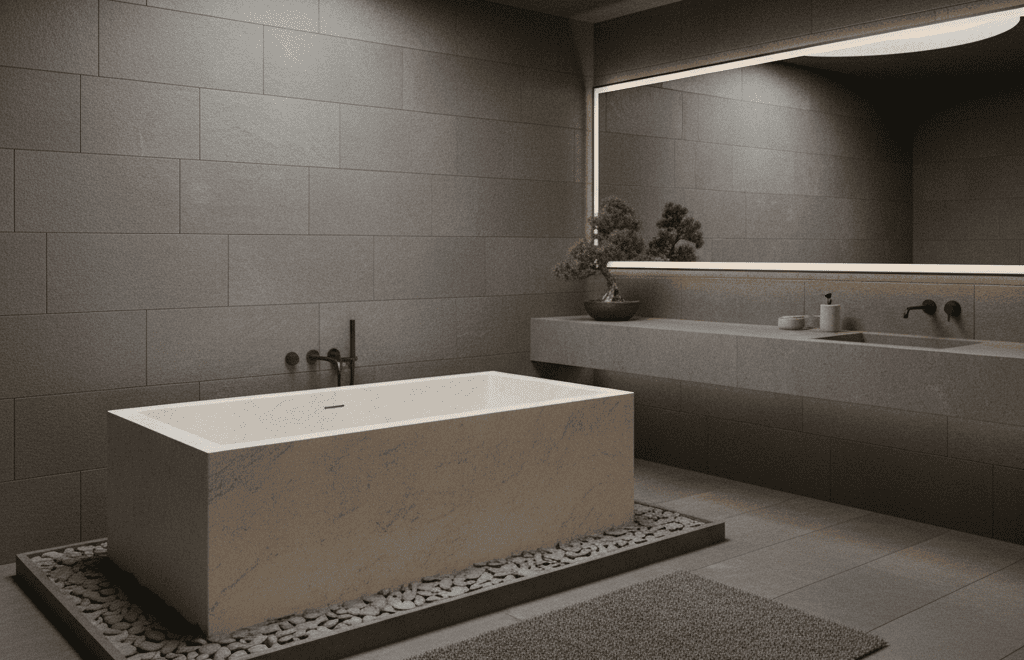How to Turn a Bathroom into a Zone of Relaxation
Bathrooms get ignored. People throw in tiles, a sink, a shower, and call it done. But if you think about it—this is the only space where you can lock the door and everyone else disappears. It deserves more than cold porcelain. It deserves softness, warmth, and a touch of theater.
I’ll say it outright: a bathroom can be the best room in your home if you let it. Not just for hygiene. For thinking. For disappearing. For mood shifts. Many designers recommend luxury bathroom with glass enclosures to create that spa-like atmosphere, and honestly, I get it.
1. Lighting that Talks Back
Skip the overhead glare. Real relaxation is layered.
- Soft LEDs under the vanity.
- A pendant over the tub.
- Dimmable sconces flanking the mirror.
Lighting isn’t just about seeing yourself brush teeth—it sets a script. A functional layout in the living room makes sense; in the bathroom, think mood choreography.
2. Materials that Breathe
Wood in a bathroom? Absolutely. Teak, cedar, bamboo. Warm underfoot. Even sealed oak. Combine with natural stone or matte concrete. That mix feels primal, like being outside but safe.
Texture layering works here—borrow the idea from transitional design. Put rough next to smooth. Let the surfaces clash a little. Your skin will notice before your eyes do.
3. Space Isn’t About Size
Even if your bathroom is cramped, it can still feel expansive. Mirrors double it. Transparent partitions keep it airy. A freestanding tub in a small square room? Bold, but it can shift the entire vibe.
Think in terms of studio hacks: folding screens, zoning tricks, bookshelves flipped as dividers. The same tools used to build a studio workspace can also give a tiny bath a sense of territory.
4. Ritual Objects
This is where personality sneaks in. A carved stool by the tub. Ceramic bowls. A single bold plant. Don’t flood the room with tchotchkes. Pick one object that becomes ritual: every time you see it, you exhale.
But “ritual” isn’t a buzzword—it’s literal. You train your brain. When the candle lights up, your mind knows: stop. When you pour water with a ladle, your muscles follow a rhythm that resets you. These small acts, repeated, become architecture for the nervous system.
Some examples that transform routine into ritual:
- Ceramics: Handmade bowls for salts or small stones.
- Natural objects: Driftwood, river rock, branches—things that remind you of outside.
- Textiles: A towel that feels different, not just functional but symbolic.
- Fire & water: Candles, incense, or even a small oil lamp paired with pouring water.
A bathroom without a ritual object feels like a gas station restroom—sterile, purely transactional. Add one anchor and the entire room bends toward calm. I keep a wooden ladle. Pouring water over hot stone makes the room feel like a sauna, even when it’s just a Tuesday shower. It doesn’t matter if the room is tiny or palatial—ritual scales down.
5. Color as Temperature
Bathrooms usually default to white. White walls, white tile, white fixtures. It’s sanitary—but sterile. Swap that for warm earth. Clay, terracotta, muted greens. Suddenly the room doesn’t scream “hospital.”
A bold splash works too. Deep indigo behind a tub can feel like a dark pool. Even one painted accent wall reshapes perception, like coworking design spaces that use one sharp color to mark territory.
6. Furniture You Don’t Expect
A chair in a bathroom? Why not. Place a lounge chair if there’s space. Or a small bench. It signals that you can sit, linger. That the bathroom isn’t just for “in and out.”
Furniture alters psychology. When you walk into a room with nothing but tile and fixtures, your brain prepares for efficiency. Add a chair and suddenly it whispers: “stay.” You might read. You might just breathe.
Ideas worth testing:
- Stools: Lightweight, movable, good for setting down clothes or books.
- Benches: Against the wall, under a window, with a folded throw—suddenly the bathroom feels like a spa lounge.
- Armchairs: If you’ve got the square footage, a fabric armchair changes everything. Not practical? Maybe. But decadent.
- Tiny tables: A round side table for a glass of wine, a candle, or even your phone if you can’t let go.
Why bother? Because furniture tells you how to use a room. The same way a desk demands work, a tub with a bench beside it demands relaxation. You’re not just cleaning your body—you’re inhabiting time differently.
And yes, practicality plays in:
- Towels can rest on the stool instead of the floor.
- A bench doubles as storage if hollow or built with a shelf.
- An upholstered chair can act as visual warmth in an otherwise cold tile box.
Bathrooms often end up echo chambers of ceramic and steel. Furniture breaks that monotony, softens acoustics, and humanizes the space.
7. Organization That Vanishes
Clutter destroys calm. Hair dryers, bottles, towels stacked randomly—it’s chaos. Hide them. Built-in niches, recessed shelves, baskets tucked under floating cabinets.
Borrow ideas from a home office: storage solutions that swallow clutter but keep essentials close. The trick is making the storage invisible. If you see it, you’ll think of work.
8. Learning from Real Projects
Starting any redesign feels overwhelming—too many choices, too much noise. That’s when solid design advice becomes more than just words. It’s about trimming mistakes before they cost you, balancing textures so the room doesn’t feel flat, and knowing when to splurge and when to hold back.
Think of it as a conversation: with yourself, with the space, maybe with a professional if you can. The key isn’t copying trends—it’s catching the small signals your room gives and answering them without fear.
9. Borrowing Tricks from the Workspace
Oddly enough, some of the smartest bathroom ideas come from office design. A studio workspace thrives on compact design, hidden storage, and multipurpose furniture—and bathrooms benefit from the exact same logic.
Glass partitions, folding screens, even modular shelving: they keep privacy intact while making the space look larger and cleaner. Add to that a sense of zones—washing, soaking, storage—and suddenly the bathroom feels less like a pit stop and more like a carefully organized habitat.
Quick Reference Table: Relaxation Elements
| Element | Purpose | Easy Upgrade |
|---|---|---|
| Lighting | Mood shift | Dimmable sconces |
| Materials | Sensory richness | Teak bath mat |
| Space tricks | Airy feeling | Frameless divider |
| Ritual object | Anchor for mind | Ceramic bowl |
| Color | Emotional tone | Indigo paint |
| Furniture | Signal to linger | Wooden stool |
| Storage | Calm surface | Hidden niche |
The Emotional Core
It’s not about money. It’s not about marble slabs or golden taps. It’s about whether the room allows you to exhale.
The real measure: do you linger after you’ve finished what you came in to do? If the answer is yes, then you’ve succeeded. A good bathroom slows time, makes minutes feel different. That’s the emotional core—rewiring your brain’s sense of pace.
Think about what triggers it:
- Light that falls in layers rather than a single harsh beam.
- Textures that tell stories—smooth stone against rough mat, warm wood against cold metal.
- Sound dampening so you hear water, not echoes.
- Scents that mark the room as distinct: eucalyptus, cedar, lavender, even plain unscented soap if it’s “your” smell.
A few truths worth admitting:
- Perfection kills calm. If everything is too polished, the room feels like a showroom. You need one imperfection—an old jar, a crack in the tile, something human.
- Personal memory beats trend. That shell you picked up on vacation will matter more than the designer soap dish.
- Silence is underrated. Fans hum, plumbing groans—but if you can tame sound, the room becomes sanctuary.
When done right, the bathroom becomes a retreat, not a utility closet with plumbing. A retreat you want to disappear into for hours. A retreat that, strangely, becomes the truest room in the house.

FAQ
Q1: What lighting works best for a relaxing bathroom?
A mix of dimmable sconces, hidden LEDs, and soft pendant lamps builds atmosphere and avoids harsh glare.
Q2: How do I make a small bathroom feel bigger?
Use mirrors, transparent partitions, and vertical storage to expand the visual space. Keep clutter hidden.
Q3: Which materials add warmth to a bathroom?
Wood (teak, cedar, bamboo) and natural stone combine durability with tactile warmth. They feel alive under hand and foot.
Q4: Is furniture in a bathroom practical?
Yes, if sized correctly. A bench, stool, or even a small lounge chair signals rest instead of rush.
